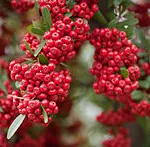The Edwards Plateau Ecoregion Dirty Dozen Terrestrial Invasive Species
View: “Invasive Non-native Plants and How to get Rid of Them” on the Fredericksburg Texas Native Gardening YouTube channel
Watch out when you are at the nursery! Invasives are hiding among the natives. You will find them offered every spring and summer in the gardening department of major stores in our area. Many of these are beautiful plants, and even though scientists have identified many of these as invasive and harmful to our environment, Texas state law states that it is perfectly legal to sell them.
texasinvasives.org, has identified these 12 plants as particularly worrisome invasive species in the Edwards Plateau ecoregion. They invade the Texas Hill Country, a territory where there is no natural protection. Click on their common names to go to the Invasive Plant Database to identify each.
Glossy privet – Ligustrum lucidum
Chinese tallow tree – Triadica sebifera ` leaves, fruit, sap are toxic to humans
Johnson grass – Sorghum halepense
Heavenly bamboo – Nandina domestica – toxic to songbirds
Chinaberry tree – Melia azedarach – mature plants produce fruit that is poisonous to humans, pets, livestock
Japanese honeysuckle – Lonicera japonica
G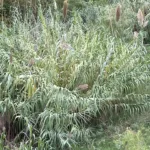 iant reed – Arundo donax This particular clump, is located in the Barons Creek drainage below Natural Grocers, Fredericksburg. photo by Jennifer Coulter. Clogs waterways creating flooding situations in heavy rains.Will regrow from smallest root or stem.
iant reed – Arundo donax This particular clump, is located in the Barons Creek drainage below Natural Grocers, Fredericksburg. photo by Jennifer Coulter. Clogs waterways creating flooding situations in heavy rains.Will regrow from smallest root or stem.
Golden rain tree – Koelreuteria paniculata
Elephant ears – Colocasia esculenta
Paper mulberry – Broussonetia papyrifera
Tree of heaven – Ailanthus altissima – sap can cause headaches and nausea when cutting and handling.
King Ranch bluestem – Bothriochloa ischaemum var. songarica – little nutritional value for livestock.Wind borne seeds, create environment that crowds out native species.
Mediterranean Mustard – a Real “Bastard Cabbage”
Additional Invasives that damage the Texas Wildscape
Bermudagrass – Cyodon dactylon – Native to Mediterranean regions of Europe and Africa. Releases chemicals that inhibits growth of other plants.
Lantana camara – Indian Lantana -Also found in the nursery trade under the cultivar names: Confetti, New Gold, and Dallas Red. Cross pollinates with native species. Prolific. spread by birds.
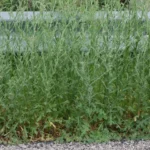
Malta star-thistle – Centaurea melitensis – Out competes native plants. Spines on the seeds prevent forage. Deep tap root.
Russian musk-thistle – Carduus nutans – Forms dense carpets that cut out light to other plants. Depletes soil of nitrogen. Does not provide forage for wildlife or livestock due to spiny nature of plants.
The immediate question. “What are invasive plants?”
The term “invasive” describes alien species , usually native to Europe, Eurasia, or Asia. According to the National Invasive Species Information Center “…these plants are characteristically adaptable to the climate and soil of their new habitats,” and cause harm to the environment or humans.
- They thrive without cultivation,
- grow aggressively with a high reproductive capacity.
- expand into natural areas displacing the native plants,
- disrupt naturally-balanced native ecosystems of plant, insect and wildlife,
- many are toxic to livestock, or like The Tree-of-Heaven, also have a bad record for being allelopathic, preventing other plants from growing nearby.
In their new location introduced exotics are without the environmental checks and balances of seasonal weather, diseases, or insect pests that kept them under control in their native range. Their vigor combined with a lack of natural enemies often leads to “outbreak populations.”
As a result invasive exotics become a monoculture – crowding out the native species and impacting the ecosystem that supports the native plant foundation. Insects native to the Edwards Plateau do not use invasives as food, habitat, or host plants for their larvae. With the destruction of the natural ecosystem, the food supply for nesting birds and the larger, key wildlife species is undermined.
How Do Invasive Species Get Here? There are several routes. Usually, we have something to do with it in some manner.
- Many of the trees native to Asia and now considered invasive were introduced as shade trees in the southern part of the United States in the early 1800s
- seeds and weeds sneak in through imported nursery plants and soils.
- landscapers and friends misidentify plants or give us unidentified plants strictly because of their beauty.
- travelers bring home fruits, flowers or seeds as souvenirs.
- then there are migratory birds who eat fruit there and poop out the seeds here.
- and the wind dispursing fine seeds. The only control we have over birds and wind is to not provide additional resource.
Apart from their beauty appreciated by travelers abroad, many species have been purposefully introduced to “improve” our natural resources.
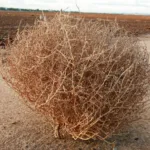 * Russian thistle (Tumbleweed), while not included in the top dirty dozen , was introduced as a cattle feed in the midwest. Wind spreads the fine seeds as the dry plants tumble.
* Russian thistle (Tumbleweed), while not included in the top dirty dozen , was introduced as a cattle feed in the midwest. Wind spreads the fine seeds as the dry plants tumble.
*The bunch grass King Ranch Bluestem (KR Bluestem) was seeded on degraded rangelands in west Texas as graze for cattle and for soil and water conservation. Wind spreads the fine seed.
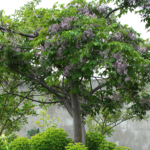
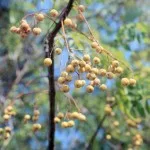 *Chinaberry (Pride of India), was imported in the early 1800’s as a shade tree. It continues to be sold widely as a popular ornamental tree. Birds spread the seeds from the berries creating monocultures.
*Chinaberry (Pride of India), was imported in the early 1800’s as a shade tree. It continues to be sold widely as a popular ornamental tree. Birds spread the seeds from the berries creating monocultures.
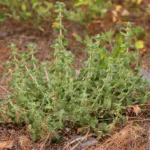 Horehound,(Marrubium vulgare L.) a native of the Mediterranean, arrived in North America with the colonists as a medicinal plant for the herb garden. (You have probably had horehound cough drops.) Its fine seeds flourish readily on disturbed ground. It grows wild now across the country.
Horehound,(Marrubium vulgare L.) a native of the Mediterranean, arrived in North America with the colonists as a medicinal plant for the herb garden. (You have probably had horehound cough drops.) Its fine seeds flourish readily on disturbed ground. It grows wild now across the country.
Pyracantha spp. – a genus of large, thorny evergreen shrubs in the family Rosaceae, native to an area extending from Southwest Europe east to Southeast Asia. Dense thorny structure makes them an alternative to artificial fences and walls. Can cause gastric distress.
Stewardship: What Can We Do As Consumers and Gardeners?
In 2017 the Board of Directors of the Fredericksburg chapter NPSOT raised the issue of the degradation of the Hill Country ecosystem with a letter sent to the largest big box stores. Our goals were to help their managers, and those in the main offices who order the plants, understand the issue, to register our concerns, and to ask them not to sell plants on the Edwards Plateau“dirty dozen” list. We can all
- Consider using plants from native plant nurseries. Native plants are best suited for your microclimate and require minimal upkeep. They also help support native fish and wildlife by providing them with the sources that they consider as foof.
- When disposing of plants with the potential of spreading, completely dry or freeze the plants to kill them. Then add them to household garbage that will not be composted. Do not dump aquatic plants into waterways.
- Learn to identify invasive non-native plants, as well as recognizing the native plants of the region.
- Remember! Plants from other regions of the world are houseguests. Help them mind their manners.


